Ad-hoc On-Demand Distance Vector Routing
Charles E. Perkins
Elizabeth M. Royer
Sun Microsystems Laboratories
Advanced Development Group
Dept. of Electrical and Computer Engineering
University of California, Santa Barbara
Menlo Park, CA ����
cperkins@eng.sun.com
Santa Barbara, CA ����
eroyer@alpha.ece.ucsb.edu
Abstract
An ad-hoc network is the cooperative engagement of
a collection of mobile nodes without the required inter-
vention of any centralized access point or existing in-
frastructure. In this paper we present Ad-hoc On De-
mand Distance Vector Routing �AODV�, a novel algo-
rithm for the operation of such ad-hoc networks. Each
Mobile Host operates as a specialized router, and routes
are obtained as needed �i.e., on-demand� with little
or no reliance on periodic advertisements. Our new
routing algorithm is quite suitable for a dynamic self-
starting network, as required by users wishing to utilize
ad-hoc networks. AODV provides loop-free routes even
while repairing broken links. Because the protocol does
not require global periodic routing advertisements, the
demand on the overall bandwidth available to the mo-
bile nodes is substantially less than in those protocols
that do necessitate such advertisements. Nevertheless
we can still maintain most of the advantages of basic
distance-vector routing mechanisms. We show that our
algorithm scales to large populations of mobile nodes
wishing to form ad-hoc networks. We also include an
evaluation methodology and simulation results to verify
the operation of our algorithm.
Keywords: Ad-hoc Networking, Distance Vector
Routing, Dynamic Routing, Mobile Networking, Wire-
less Networks
�. Introduction
Laptop computers continue to show improvements
in convenience, mobility, memory capacity, and avail-
ability of disk storage. These smaller computers can
be equipped with gigabytes of disk storage, high res-
olution color displays, pointing devices, and wireless
communications adapters. Moreover, because many of
these small �in size only� computers operate with bat-
tery power, users are free to move about at their con-
venience without being constrained by wires.
The idea of forming an on-the-�y ad-hoc network of
mobile nodes dates back to DARPA packet radio net-
work days ���, ���. More recently the interest in this
subject has grown due to availability of license-free,
wireless communication devices that users of laptop
computers can use to communicate with each other.
Several recent papers on this topic have focused on the
algorithmic complexity of choosing the optimal set of
ad-hoc routers ��, �, ���, while others have proposed
new routing solutions ��, �, ��, ��, ��, ��� leverag-
ing features from the existing Internet routing algo-
rithms. Interest within the Internet Engineering Task
Force �IETF� is also growing as is evidenced by the for-
mation of a new working group �manet ��, ���� whose
charter is to develop a solution framework for rout-
ing in ad-hoc networks. The manet working group has
goals that are quite distinct from the goals of the IETF
mobileip working group, and make little or no use of
Mobile IP ���� or any of its forerunners �e.g., � , ����.
The Destination-Sequenced Distance Vector
�DSDV� algorithm has been proposed ���� as a variant
of the distance vector routing method by which mobile
nodes cooperate to form an ad-hoc network. DSDV is
e�ective for creating ad-hoc networks for small popu-
lations of mobile nodes, but it is a fairly brute force
approach because it depends for its correct operation
on the periodic advertisement and global dissemina-
tion of connectivity information. Frequent system-wide
broadcasts limit the size of ad-hoc networks that can
e�ectively use DSDV because the control message over-
head grows as O�n��. DSDV also requires each mobile
node to maintain a complete list of routes, one for each
destination within the ad-hoc network. This almost al-
ways exceeds the needs of any particular mobile node.
Keeping a complete routing table does reduce route ac-
quisition latency before transmission of the �rst packet
to a destination. It is, however, possible to design a sys-
�
tem whereby routes are created on-demand �e.g., �����.
Such systems must take steps to limit the time used for
route acquisition; otherwise, users of the ad-hoc nodes
might experience unacceptably long waits before trans-
mitting urgent information. The advantage here is that
a smoothly functioning ad-hoc system with on-demand
routes could largely eliminate the need for periodic
broadcast of route advertisements. With the goals of
minimizing broadcasts and transmission latency when
new routes are needed, we designed a protocol to im-
prove upon the performance characteristics of DSDV
in the creation and maintenance of ad-hoc networks.
Although AODV does not depend speci�cally on
particular aspects of the physical medium across which
packets are disseminated, its development has been
largely motivated by limited range broadcast media
such as those utilized by infrared or radio frequency
wireless communications adapters. Using such media,
a mobile node can have neighbors which hear its broad-
casts and yet do not detect each other �the hidden ter-
minal problem �����. We do not make any attempt to
use speci�c characteristics of the physical medium in
our algorithm, nor to handle speci�c problems posed
by channelization needs of radio frequency transmit-
ters. Nodes that need to operate over multiple chan-
nels are presumed to be able to do so. The algorithm
works on wired media as well as wireless media, as long
as links along which packets may be transmitted are
available. The only requirement placed on the broad-
cast medium is that neighboring nodes can detect each
others’ broadcasts.
AODV uses symmetric links between neighboring
nodes.
It does not attempt to follow paths between
nodes when one of the nodes cannot hear the other one;
however we may include the use of such links in future
enhancements. Steps to prevent use of such asymmet-
ric links between nodes are described brie�y in Sec-
tion �.�.
The remainder of this paper is organized as follows.
In Section �, the protocol details for AODV are given.
Section � presents the simulations, input parameters,
and results obtained. Section � describes our plans for
future work, and �nally Section � concludes the paper.
�. The Ad-hoc On-Demand Distance
Vector Algorithm
Our basic proposal can be called a pure on-demand
route acquisition system; nodes that do not lie on ac-
tive paths neither maintain any routing information
nor participate in any periodic routing table exchanges.
Further, a node does not have to discover and maintain
a route to another node until the two need to commu-
nicate, unless the former node is o�ering its services
as an intermediate forwarding station to maintain con-
nectivity between two other nodes.
When the local connectivity of the mobile node is
of interest, each mobile node can become aware of the
other nodes in its neighborhood by the use of several
techniques,
including local �not system-wide� broad-
casts known as hello messages. The routing tables of
the nodes within the neighborhood are organized to op-
timize response time to local movements and provide
quick response time for requests for establishment of
new routes. The algorithm’s primary objectives are:
� To broadcast discovery packets only when neces-
sary
� To distinguish between local connectivity manage-
ment �neighborhood detection� and general topol-
ogy maintenance
� To disseminate information about changes in lo-
cal connectivity to those neighboring mobile nodes
that are likely to need the information.
AODV uses a broadcast route discovery mecha-
nism ���, as is also used �with modi�cations� in the Dy-
namic Source Routing �DSR� algorithm ����. Instead
of source routing, however, AODV relies on dynam-
ically establishing route table entries at intermediate
nodes. This di�erence pays o� in networks with many
nodes, where a larger overhead is incurred by carry-
ing source routes in each data packet. To maintain
the most recent routing information between nodes,
we borrow the concept of destination sequence num-
bers from DSDV ����. Unlike in DSDV, however, each
ad-hoc node maintains a monotonically increasing se-
quence number counter which is used to supersede stale
cached routes. The combination of these techniques
yields an algorithm that uses bandwidth e�ciently �by
minimizing the network load for control and data traf-
�c�, is responsive to changes in topology, and ensures
loop-free routing.
2.1. Path Discovery
The Path Discovery process is initiated whenever a
source node needs to communicate with another node
for which it has no routing information in its table.
Every node maintains two separate counters: a node
sequence number and a broadcast id. The source node
initiates path discovery by broadcasting a route request
�RREQ� packet to its neighbors. The RREQ contains
the following �elds:
� source addr; source sequence �; broadcast id;
dest addr; dest sequence �; hop cnt �
�
�
The pair � source addr; broadcast id � uniquely
identi�es a RREQ. broadcast id is incremented when-
ever the source issues a new RREQ. Each neighbor
either satis�es the RREQ by sending a route reply
�RREP� back to the source �see Section �.�.��, or re-
broadcasts the RREQ to its own neighbors after in-
creasing the hop cnt. Notice that a node may receive
multiple copies of the same route broadcast packet from
various neighbors. When an intermediate node receives
a RREQ, if it has already received a RREQ with the
same broadcast id and source address, it drops the re-
dundant RREQ and does not rebroadcast it. If a node
cannot satisfy the RREQ, it keeps track of the follow-
ing information in order to implement the reverse path
setup, as well as the forward path setup that will ac-
company the transmission of the eventual RREP:
� Destination IP address
� Source IP address
� Broadcast id
� Expiration time for reverse path route entry
� Source node’s sequence number.
D
D
S
timeout
S
Figure 1. Reverse
Path Formation
Figure 2. Forward
Path Formation
2.1.1. Reverse Path Setup
There are two sequence numbers �in addition to
the broadcast id� included in a RREQ: the source se-
quence number and the last destination sequence num-
ber known to the source. The source sequence number
is used to maintain freshness information about the re-
verse route to the source, and the destination sequence
number speci�es how fresh a route to the destination
must be before it can be accepted by the source.
�
As the RREQ travels from a source to various desti-
nations, it automatically sets up the reverse path from
all nodes back to the source ���, as illustrated in Fig-
ure �. To set up a reverse path, a node records the
address of the neighbor from which it received the �rst
copy of the RREQ. These reverse path route entries are
maintained for at least enough time for the RREQ to
traverse the network and produce a reply to the sender.
2.1.2. Forward Path Setup
Eventually, a RREQ will arrive at a node �possibly
the destination itself� that possesses a current route to
the destination. The receiving node �rst checks that
the RREQ was received over a bi-directional link. If
an intermediate node has a route entry for the desired
destination, it determines whether the route is current
by comparing the destination sequence number in its
own route entry to the destination sequence number
in the RREQ. If the RREQ’s sequence number for the
destination is greater than that recorded by the inter-
mediate node, the intermediate node must not use its
recorded route to respond to the RREQ. Instead, the
intermediate node rebroadcasts the RREQ. The inter-
mediate node can reply only when it has a route with
a sequence number that is greater than or equal to
that contained in the RREQ. If it does have a current
route to the destination, and if the RREQ has not been
processed previously, the node then unicasts a route re-
ply packet �RREP� back to its neighbor from which it
received the RREQ. A RREP contains the following
information:
� source addr; dest addr; dest sequence �;
hop cnt; lif etime �
By the time a broadcast packet arrives at a node
that can supply a route to the destination, a re-
verse path has been established to the source of the
RREQ �Section �.�.��. As the RREP travels back
to the source, each node along the path sets up a
forward pointer to the node from which the RREP
came, updates its timeout information for route en-
tries to the source and destination, and records the
latest destination sequence number for the requested
destination. Figure � represents the forward path
setup as the RREP travels from the destination D
to the source node S. Nodes that are not along the
path determined by the RREP will timeout after AC-
TIVE ROUTE TIMEOUT ����� msec� and will delete
the reverse pointers.
A node receiving an RREP propagates the �rst
RREP for a given source node towards that source.
If it receives further RREPs, it updates its routing in-
formation and propagates the RREP only if the RREP
�
contains either a greater destination sequence number
than the previous RREP, or the same destination se-
quence number with a smaller hopcount. It suppresses
all other RREPs it receives. This decreases the num-
ber of RREPs propagating towards the source while
also ensuring the most up-to-date and quickest routing
information. The source node can begin data trans-
mission as soon as the �rst RREP is received, and can
later update its routing information if it learns of a
better route.
2.2. Route Table Management
Each time a route entry is used to transmit data
from a source toward a destination,
the timeout
for the entry is reset to the current time plus ac-
tive route timeout.
If a new route is o�ered to a mobile node, the mo-
bile node compares the destination sequence number
of the new route to the destination sequence number
for the current route. The route with the greater se-
quence number is chosen. If the sequence numbers are
the same, then the new route is selected only if it has
a smaller metric �fewer number of hops� to the desti-
nation.
In addition to the source and destination sequence
numbers, other useful information is also stored in the
route table entries, and is called the soft-state asso-
ciated with the entry. Associated with reverse path
routing entries is a timer, called the route request ex-
piration timer. The purpose of this timer is to purge
reverse path routing entries from those nodes that do
not lie on the path from the source to the destination.
The expiration time depends upon the size of the ad-
hoc network. Another important parameter associated
with routing entries is the route caching timeout, or the
time after which the route is considered to be invalid.
In each routing table entry, the address of active
neighbors through which packets for the given desti-
nation are received is also maintained. A neighbor
is considered active �for that destination� if it origi-
nates or relays at least one packet for that destination
within the most recent active timeout period. This in-
formation is maintained so that all active source nodes
can be noti�ed when a link along a path to the des-
tination breaks. A route entry is considered active if
it is in use by any active neighbors. The path from
a source to a destination, which is followed by pack-
ets along active route entries, is called an active path.
Note that, as with DSDV, all routes in the route table
are tagged with destination sequence numbers, which
guarantee that no routing loops can form, even under
extreme conditions of out-of-order packet delivery and
high node mobility �see Appendix A�.
A mobile node maintains a route table entry for each
destination of interest. Each route table entry contains
the following information:
� Destination
� Next Hop
� Number of hops �metric�
� Sequence number for the destination
� Active neighbors for this route
� Expiration time for the route table entry
2.3. Path Maintenance
Movement of nodes not lying along an active path
does not a�ect the routing to that path’s destination.
If the source node moves during an active session, it
can reinitiate the route discovery procedure to estab-
lish a new route to the destination. When either the
destination or some intermediate node moves, a special
RREP is sent to the a�ected source nodes. Periodic
hello messages can be used to ensure symmetric links,
as well as to detect link failures, as described in Sec-
tion �.�. Alternatively, and with far less latency, such
failures could be detected by using link-layer acknowl-
edgments �LLACKS�. A link failure is also indicated if
attempts to forward a packet to the next hop fail.
Once the next hop becomes unreachable, the node
upstream of the break propagates an unsolicited RREP
with a fresh sequence number �i.e., a sequence number
that is one greater than the previously known sequence
number� and hop count of � to all active upstream
neighbors. Those nodes subsequently relay that mes-
sage to their active neighbors and so on. This pro-
cess continues until all active source nodes are noti�ed;
it terminates because AODV maintains only loop-free
routes and there are only a �nite number of nodes in
the ad-hoc network.
Upon receiving noti�cation of a broken link, source
nodes can restart the discovery process if they still re-
quire a route to the destination. To determine whether
a route is still needed, a node may check whether the
route has been used recently, as well as inspect upper-
level protocol control blocks to see whether connec-
tions remain open using the indicated destination. If
the source node �or any other node along the previ-
ous route� decides it would like to rebuild the route to
the destination, it sends out an RREQ with a desti-
nation sequence number of one greater than the previ-
ously known sequence number, to ensure that it builds
a new, viable route, and that no nodes reply if they
still regard the previous route as valid.
�
�
Simulated protocol
Packet size �bytes�
Packet count
Inter-arrival time of data packets
Session interval �sec�
S DATA
UDP
��
Exponential-mean ���� Exponential-mean ����
�� msec
Geometric-mean ��
�� msec
Geometric-mean ���
VOICE
UDP
���
Table 1. Session-Dependent Traffic Parameters.
2.4. Local Connectivity Management
Nodes learn of their neighbors in one of two ways.
Whenever a node receives a broadcast from a neigh-
bor, it updates its local connectivity information to
ensure that it includes this neighbor.
In the event
that a node has not sent any packets to all of its ac-
tive downstream neighbors within hello interval, it
broadcasts to its neighbors a hello message �a spe-
cial unsolicited RREP�, containing its identity and
sequence number. The node’s sequence number is
not changed for hello message transmissions. This
hello message is prevented from being rebroadcast out-
side the neighborhood of the node because it con-
tains a time to live �TTL� value of �. Neighbors
that receive this packet update their local connectiv-
ity information to the node. Receiving a broadcast
or a hello from a new neighbor, or failing to receive
allowed hello loss consecutive hello messages from
a node previously in the neighborhood, is an indica-
tion that the local connectivity has changed. Fail-
ing to receive hello messages from inactive neighbors
does not trigger any protocol action.
If hello mes-
sages are not received from the next hop along an ac-
tive path, the active neighbors using that next hop
are sent noti�cation of link failure as described in
Section �.�. We have determined the optimal value
for allowed hello loss is two, as is shown in Sec-
tion �.�.
The local connectivity management with hello mes-
sages can also be used to ensure that only nodes with
bidirectional connectivity are considered to be neigh-
bors. For this purpose, each hello sent by a node lists
the nodes from which it has heard. Each node checks
to make sure that it uses only routes to neighbors that
have heard the node’s hello message. To save local
bandwidth, such checking should be performed only if
explicitly con�gured into the nodes.
�. Simulations and Results
We have simulated AODV using an event-driven,
packet-level simulator called PARSEC���, which was
developed at UCLA as the successor to Maisie���. The
PARSEC language is suited to the simulation of dy-
namic topologies and routing algorithms.
The main objective of our simulations is to show
that on-demand route establishment with AODV is
both quick and accurate. Additional objectives include
showing that AODV scales well to large networks, and
determining the optimal value for each of the necessary
parameters.
3.1. Simulation Environment
Our simulations were run using networks of ��, ���,
���, and ���� nodes. The movement algorithm for all
network sizes is the same. Nodes are initially placed
randomly within a �xed-size L � L area. During the
simulation, nodes are free to move anywhere within this
area. Each node chooses a speed from a uniform distri-
bution between �.� and �.� meters per second. It then
travels towards a random spot within the L � L area.
The node moves until it reaches that spot, then chooses
a rest period from a uniform distribution between ��
and ��� seconds. After the rest period, the node travels
towards another randomly selected spot. This process
repeats throughout the simulation, causing continuous
changes in the topology of the underlying network.
Each of the simulations also uses the same channel
model. Before beginning a transmission, carrier sens-
ing is performed by a node to determine whether any
of its neighbors is transmitting. If the node detects an
ongoing transmission by a neighbor, it calculates an ex-
ponential backo� based on the number of times it has
attempted the retransmission and waits this amount of
time before listening to the channel again. A node at-
tempts to transmit a packet max retrans times before
dropping the packet.
Nodes in the simulation frequently su�er from the
hidden terminal problem. If node A transmits to node
B, and node C, unable to hear node A’s transmission,
simultaneously transmits to node B, we assume the
packets collide at node B and both packets are dropped.
Each node creates a session to another node selected
at random. The sessions created for each simulation
�
�
Hello Interval
Route Discovery Timeout
Route Expiration
Reverse Route Life
Maximum � of Retransmissions
���� msec
���� msec
���� msec
���� msec
��
Table 2. Simulated Parameter Values
are of homogeneous type; they are either small data
�S DATA� packets or voice data. The parameters for
each of the session types are given in Table �. We chose
to use the small data packet sessions for most of our
simulations because the larger size of the voice packets
and the greater number of sessions generated tended to
congest the network and hence decrease the goodput
ratio. Nevertheless, we include the results from these
simulations to o�er a contrast to the lighter demands
of the small data packets and to place a greater stress
on the protocol.
A session sends data segments until either it has
sent the desired number of segments or it receives a
timeout message from the network layer. Timeouts are
triggered when a node has sent a RREQ for a particular
destination and has not received a valid route within
route discovery timeout. Any time a route is not
available during a session, packets are dropped by the
network layer. The data rate for both session types is
�.� Mbit�sec.
Each simulation is run for ��� seconds, and new ses-
sions are generated throughout the simulation. Hence,
we keep track of, and account for, any uncompleted
sessions and data packets in transit at the end of the
simulation.
The interconnection pattern of an ad-hoc network
is determined in part by the communication range
�Rmax�. For our simulations, we held Rmax constant
at ��m. Two nodes can communicate directly, and are
thus considered each other’s neighbors, if they are less
than Rmax distance apart. The room size for the ��
and ��� nodes networks is ��m���m. For ��� nodes,
we found ��m���m to be too small, so we increased the
dimensions to ���m����m. Similarly, for ���� nodes
we used a room size of ���m����m.
Table � gives the values of the essential parameters
for AODV. The parameter values were chosen because
they minimize network congestion while allowing the
algorithm to operate as quickly and as accurately as
possible.
3.2. Results and Discussion
Our �rst objective was to show that AODV can
�nd routes quickly and accurately. Since we did not
at this time know an optimal value for rreq retries
and allowed hello loss, we varied rreq retries be-
tween � and � and set allowed hello loss to �, a
value we intuitively guessed would be reasonable. Fig-
ure � shows the goodput ratios for �� and ��� nodes
using the S DATA session type. For �� nodes, the
goodput ratio is consistently above ��. For ���
nodes, the goodput ratio for rreq retries=� is ap-
proximately ��, but then it decreases to �� for
rreq retries=� and then increases with increasing
values of rreq retries. Broch et al. ��� simulated
AODV over a network of �� nodes and achieved good-
put ratios between �� and ����, depending on the
amount of time the nodes were stationary during the
simulation. Note that our S DATA simulation uses
the same size data packets as they did. Hence, our
)
%
(
t
u
p
d
o
o
G
100
99
98
97
96
95
94
93
92
91
90
50 Nodes
100 Nodes
0
0.5
1
1.5
2
2.5
3
RREQ_RETRIES
)
%
(
t
u
p
d
o
o
G
100
99
98
97
96
95
94
93
92
91
90
50 Nodes
100 Nodes
0
0.5
1
2
ALLOWED_HELLO_LOSS
1.5
2.5
3
Figure 3. Achieved Goodput for Varying
rreq retries
Figure 4. Achieved Goodput for Varying
allowed hello loss
�
�
50 Nodes
100 Nodes
300
250
200
150
)
c
e
s
m
(
y
c
n
e
t
a
L
n
o
600
500
400
300
)
c
e
s
m
(
y
c
n
e
t
a
L
n
o
50 Nodes
100 Nodes
i
i
t
i
s
u
q
c
A
e
i
i
t
i
s
u
q
c
A
e
100
t
u
o
R
50
0
0
0.5
1
1.5
2
2.5
3
RREQ_RETRIES
200
t
u
o
R
100
0
0
0.5
1
2
ALLOWED_HELLO_LOSS
1.5
2.5
3
Figure 5. Route Acquisition Latency for
Figure 6. Route Acquisition Latency for
Varying rreq retries
Varying allowed hello loss
achieved goodput ratio for a �� node network roughly
corresponds with their results for the same size net-
work, with our results being slightly better. We disre-
gard the arti�cially high goodput ratio for ��� nodes
and rreq retries=� because ��� more of the ses-
sions aborted in this simulation than in the simulations
with larger rreq retries values. Given the remaining
goodput ratios for �� and ��� nodes, we set the optimal
rreq retries value to �.
We then simulated �� and ��� nodes networks
with rreq retries=� and varied the allowed
hello loss parameter. The results of these simu-
lations are shown in Figure �. Here, for �� nodes,
allowed hello loss=� produced the best results,
while for ��� nodes allowed hello loss=� was the
best. Again, because � is an unrealistic value, and
because allowed hello loss=� produced the second
best results, we chose allowed hello loss = � to be
the optimal value. This contradicts Broch et al.’s
�nding that allowed hello loss = � produces bet-
ter performance.
In their simulations they also used
rreq retries = �. The combination of the two pa-
rameters may account for the slightly decreased good-
put that their AODV simulations produced. Another
signi�cant di�erence between their simulation and ours
is that they set ROUTE DISCOVERY TIMEOUT to
���� msec, whereas we found the optimal value to be
���� msec.
To show that AODV �nds routes in a timely man-
ner, we examined the route acquisition latency. The
route acquisition latency was computed by noting the
simulation time when an initial RREQ was broadcast
for a given destination, and then noting the time when
the �rst RREP was received at the source. For suc-
cessive RREQ retries for the same route, the start
time for the route was held at the time at which the
�rst RREQ was sent. If a route to a destination was
never found, this time lapse was not taken into account
in the computation. Figure � shows the computed
route acquisition latencies for varying rreq retries
values, and Figure � shows the corresponding values
for varying allowed hello loss values. With the
exception of rreq retries = �, the minimum route
acquisition latency was attained for the combination
rreq retries=�, allowed hello loss=�, giving fur-
ther credence to our choice of parameter values.
Table � gives the essential results of our simulations
for networks of ��, ���, ���, and ���� nodes. The re-
sults were obtained using the S DATA session type, and
setting rreq retries=� and allowed hello loss=�.
The bandwidth overhead ratio is a metric taken from
���� �although there it is called bandwidth utilization�,
and is computed by dividing the total number of bits
transmitted by the total number of data bits trans-
mitted. We include this calculation because it gives
a good representation of the amount of control over-
head associated with a protocol. We also report both
the instantaneous goodput ratio at the simulation end,
as well as the average goodput ratio throughout the
simulation, because these numbers can vary due to
a sudden increase in link breakages or session cre-
ations at the end of the simulation. The ���� node
simulation was run for a shorter period of time be-
cause of the di�culty of running such a large simu-
lation. Also, the ��� and ���� node simulations had
a slightly larger session generation interval than the
�� and ��� nodes networks in order to keep the to-
tal number of sessions more manageable. We note
that the results of the ��� and ���� node networks
are not as good as we would have desired. Reasons
for the decreased goodput ratio are a much greater
collision rate, due to the increase in the number of
�
�
� of Nodes
Goodput Ratio at sim end
Goodput Ratio avg
Bandwidth Overhead Ratio
Avg Rte Acq Latency �msec�
Avg Path Length �hops�
Loss to Collision
Room Size �m�
Simulation Length �sec�
� Generated Sessions
� Completed Sessions
� Aborted Sessions
�.��
���
�.��
�.��
���
�.��
���
���
����
��
�.��� �. �� ��.��� ��.���
�. �� �. �� ��.��� ��.���
�.��
���
�. �
�.��� �.��� ��.��� ��.���
��x��
���x���
���
���
���
��
���
��
�
��
���x���
���
���
���
��
��x��
���
��
��
�
�.�
���
��.��
Table 3. Summary of S DATA Results
nodes and the longer paths causing a greater like-
lihood for collisions during the hop-by-hop forward-
ing of the message, and the added interference of all
the hello messages. Also, the route acquisition la-
tency increased due to the larger average path length
and the additional delay in control message trans-
mission because of increased competition for channel
access. However, regardless of the decreased perfor-
mance values, AODV is currently one of the most
scalable ad-hoc routing protocols. We feel that with
networks this large we are pushing the current capa-
bilities of mobile networks, as we are not aware of
any other attempts to model networks of such a large
size.
We also ran simulations of the �� and ��� node net-
works using the voice session type described in Sec-
tion �.�. We used this session type to stress the abil-
ities of AODV. The results of these simulations, to-
gether with the comparable results from the S DATA
session type, are given in Table �. The two im-
portant results from these simulations are the good-
put ratio and the bandwidth overhead ratio. The
goodput ratio for the voice session type was lower
than that of the S DATA sessions. This is due to
the fact that there were signi�cantly more collisions
due to the longer data packet lengths. Also, be-
cause the data packets were larger and took longer
to transmit, we found that the queues of the nodes
frequently backed up because they had to wait for
channel access for possibly lengthy periods of time,
causing delays in sending RREQs and RREPs. On
the other hand, if we compare the bandwidth over-
head ratio between the two session types, we �nd that
the voice sessions had more optimal results than the
S DATA sessions. This is because for virtually the
same amount of control overhead �i.e. the same number
of RREQs and RREPs�, the voice sessions send many
more data bits because of the increased data packet
size.
�. Current Status and Future Work
Currently, AODV has been speci�ed in an Inter-
net Draft �� � submitted to the IETF manet working
group. There are a number of further improvements
which may support larger populations of ad-hoc users,
or improve response time to route queries, or increase
the capabilities of the protocol.
4.1. Multicast
Multicast, as a basic tool for conferencing applica-
tions, must be considered when designing routing al-
gorithms for ad-hoc networks. We have already en-
hanced AODV to provide multicast capability. Mul-
ticast using AODV follows directly from the Route
Request�Route Reply message cycle and requires only
one additional message type, the Multicast Validation
Message. Nodes in the network that are members
of the same multicast group, together with the nodes
used as routers to connect group members, form a bi-
directional multicast tree across which multicast data
packets are relayed. The MACT message is used to
select the node which a source node chooses as its next
hop for the multicast tree. Additionally, there is a mul-
ticast group leader that is responsible for incrementing
the multicast group sequence number. More details of
the multicast portion of AODV can be found in �� �.
�
�
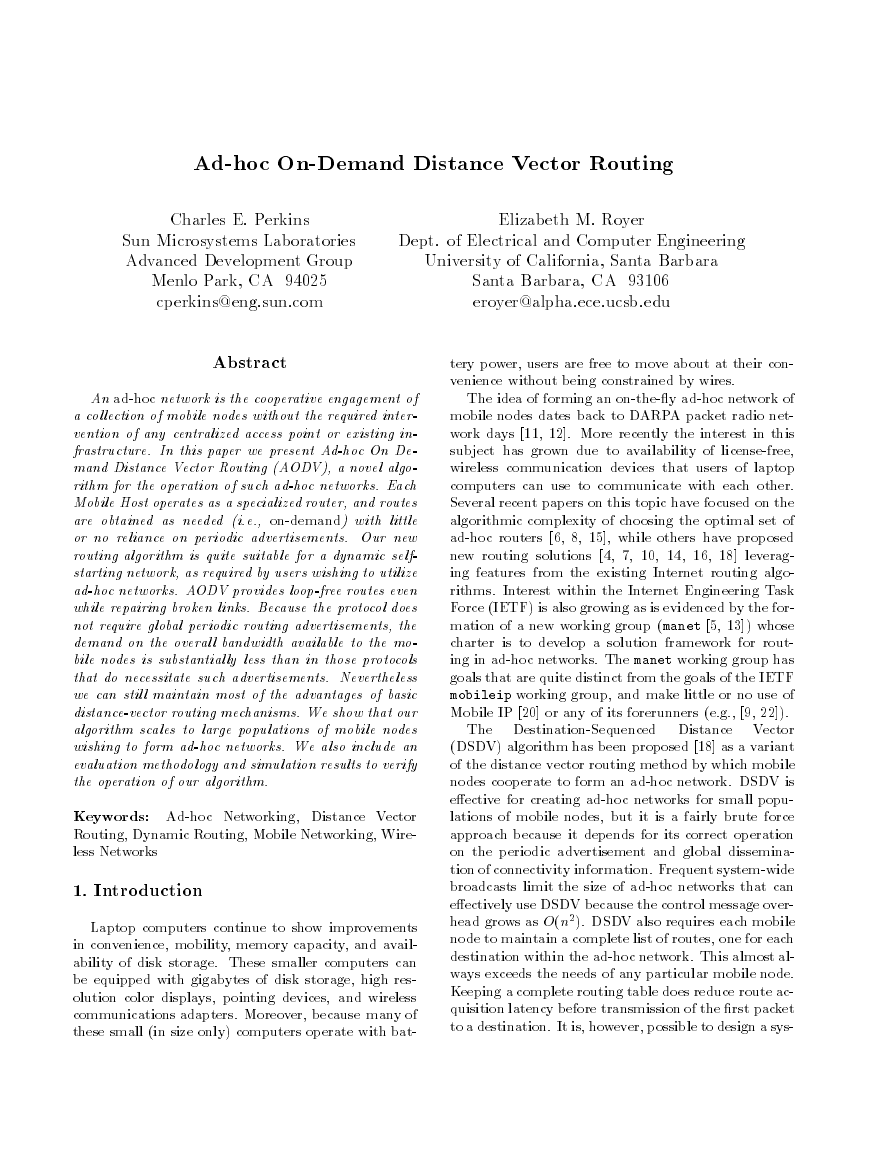
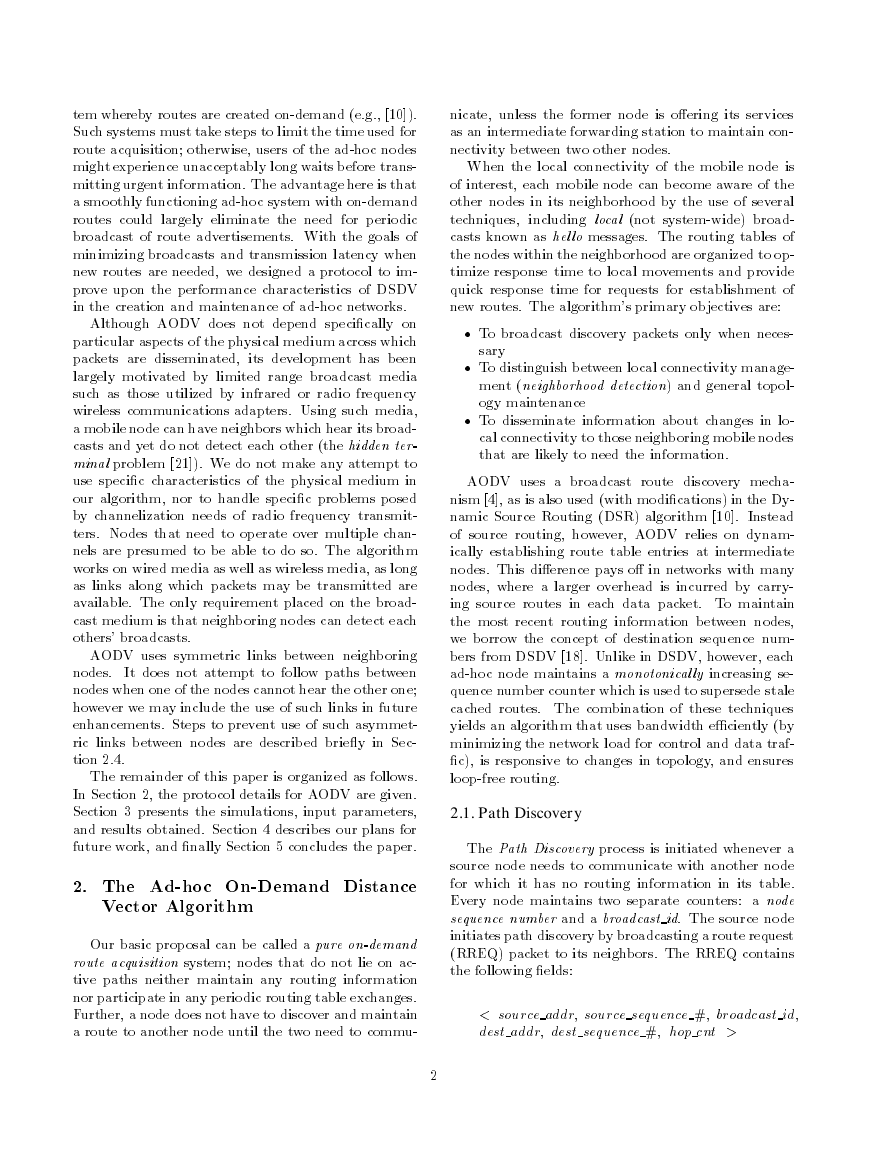
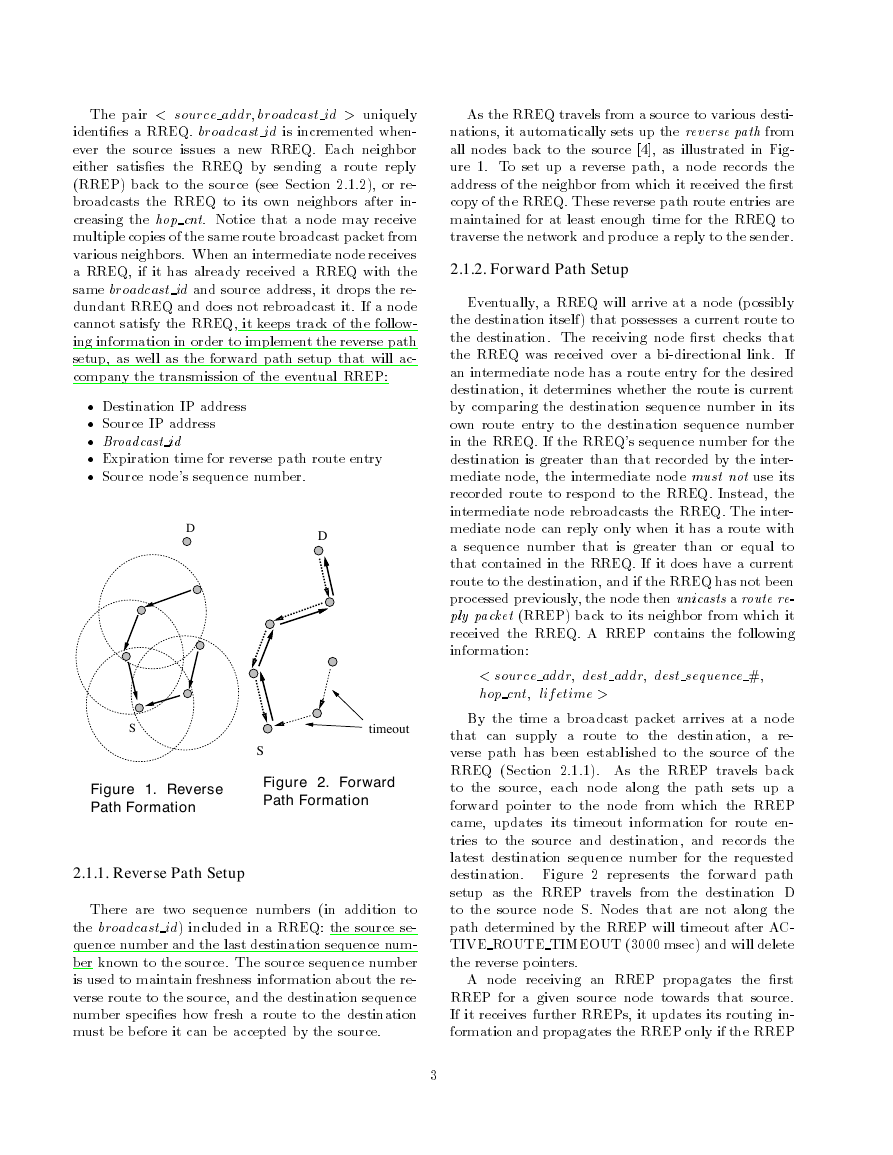

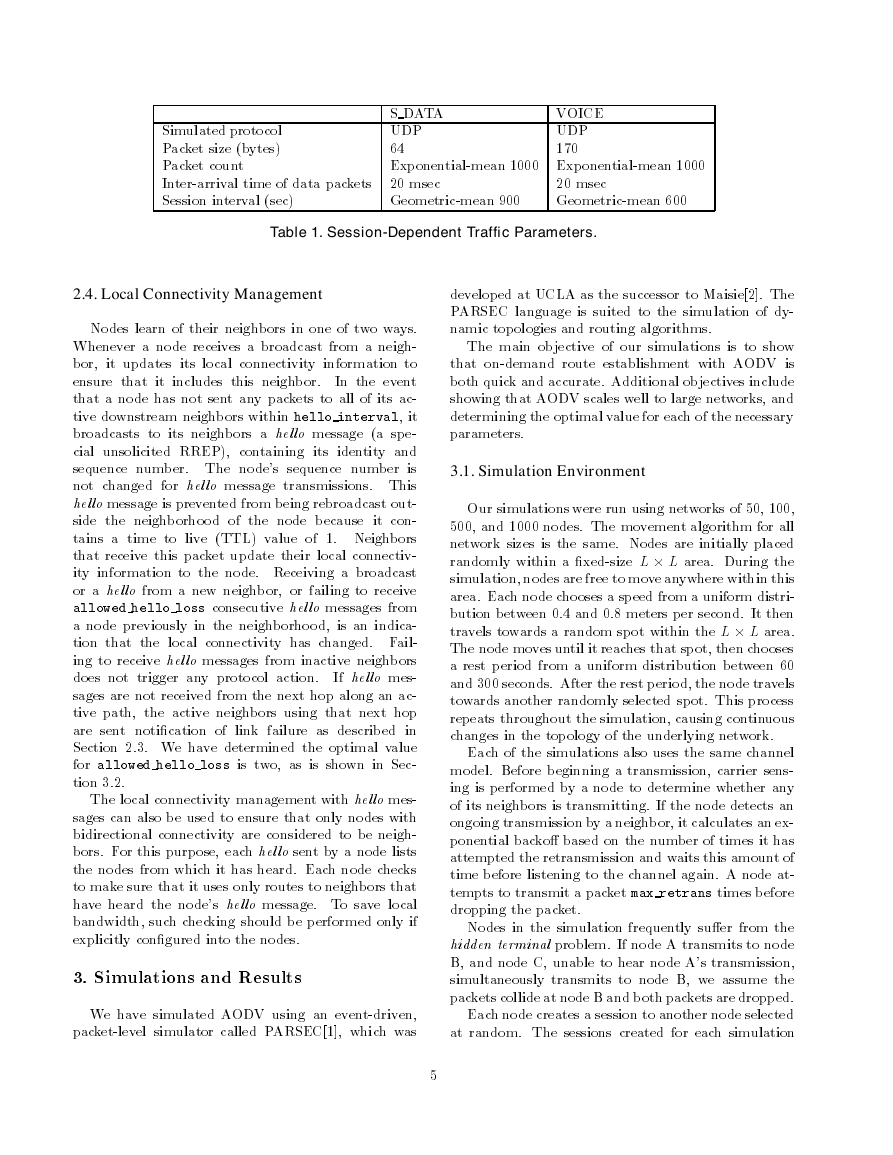
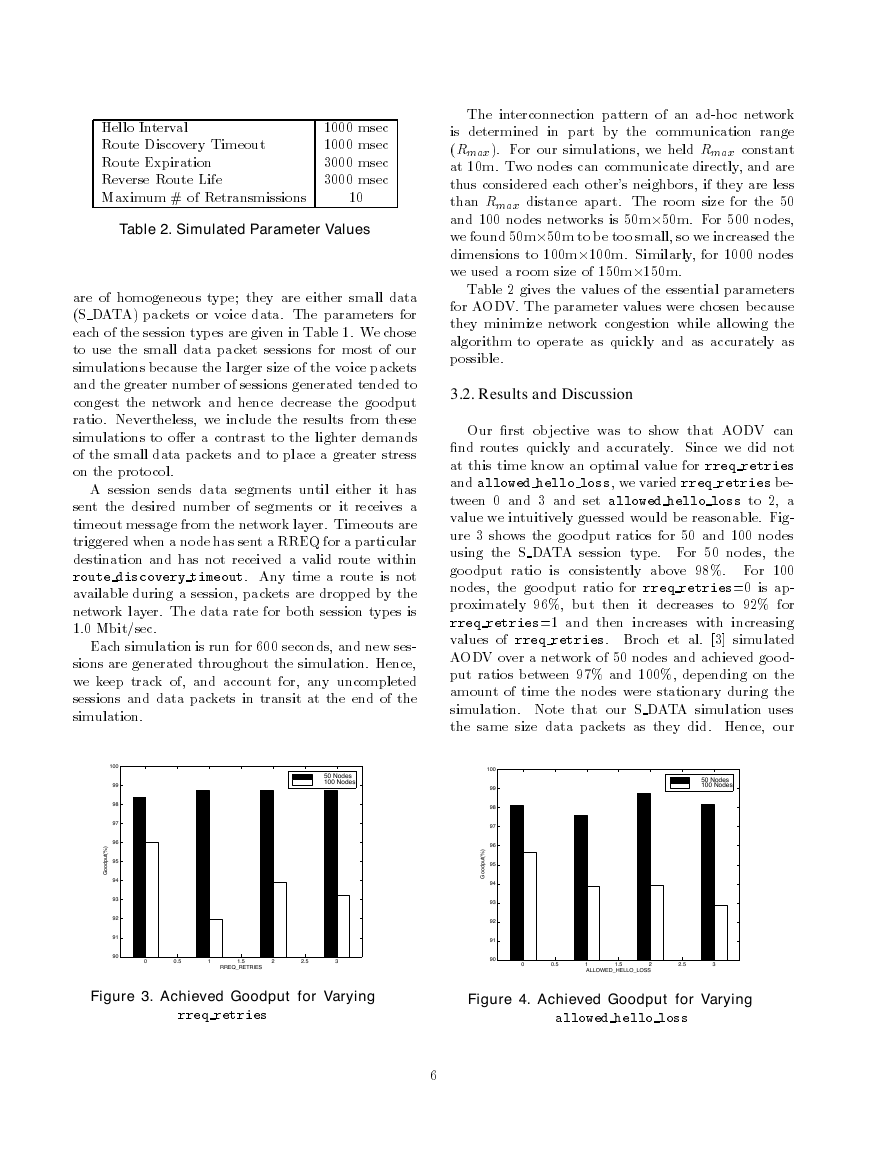
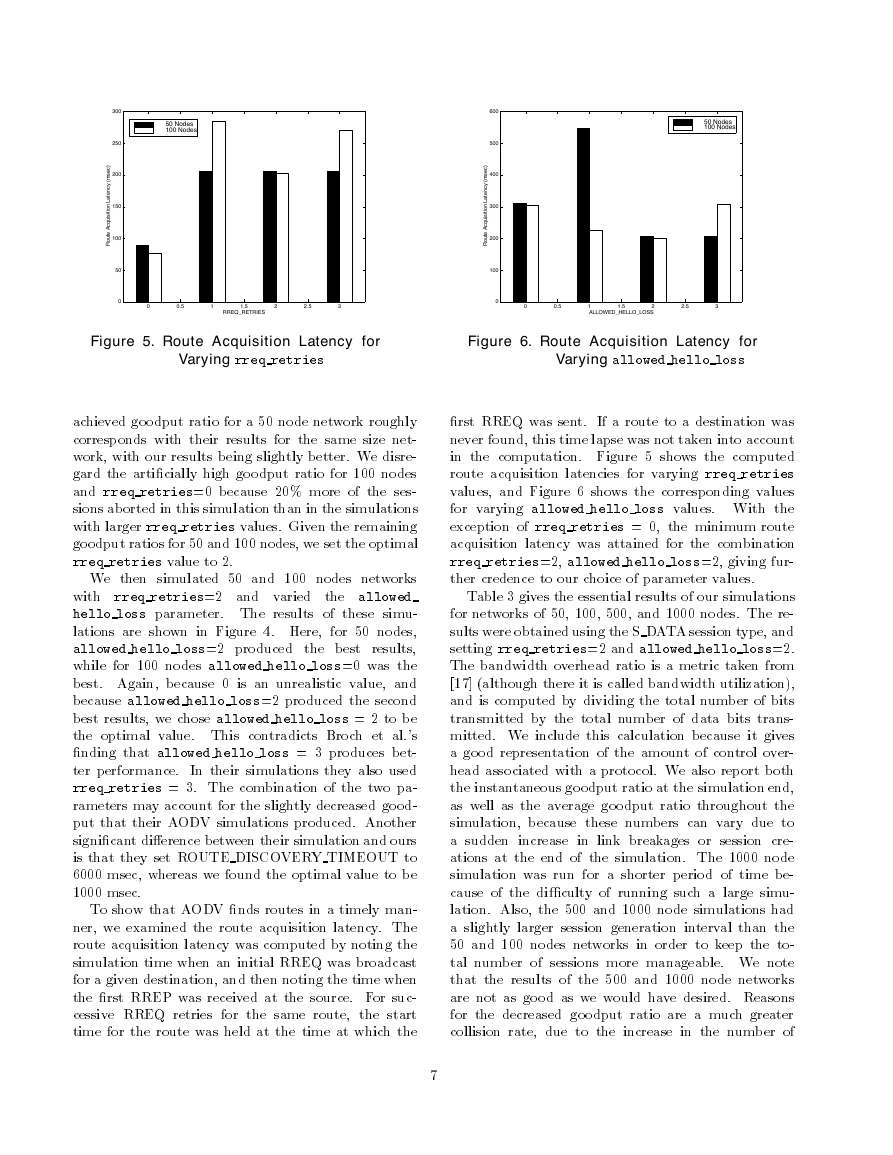
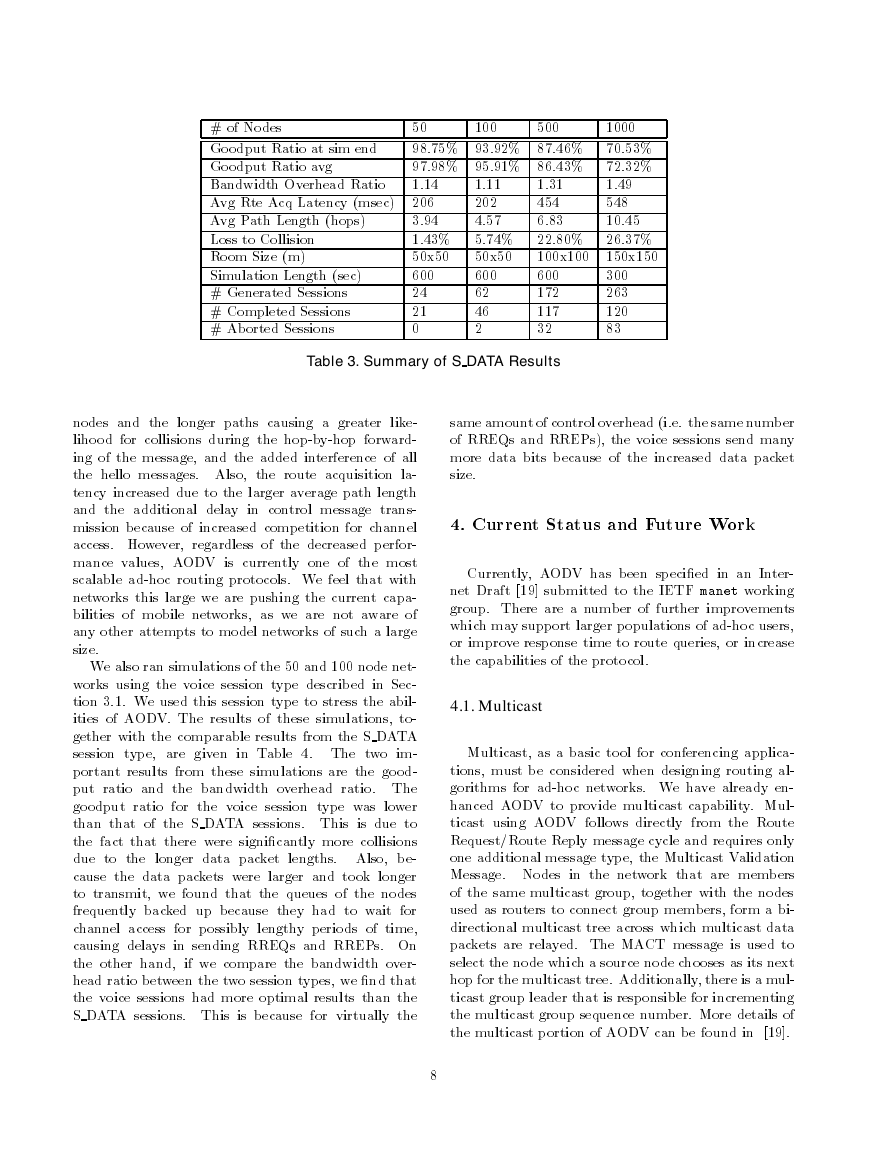








 2023年江西萍乡中考道德与法治真题及答案.doc
2023年江西萍乡中考道德与法治真题及答案.doc 2012年重庆南川中考生物真题及答案.doc
2012年重庆南川中考生物真题及答案.doc 2013年江西师范大学地理学综合及文艺理论基础考研真题.doc
2013年江西师范大学地理学综合及文艺理论基础考研真题.doc 2020年四川甘孜小升初语文真题及答案I卷.doc
2020年四川甘孜小升初语文真题及答案I卷.doc 2020年注册岩土工程师专业基础考试真题及答案.doc
2020年注册岩土工程师专业基础考试真题及答案.doc 2023-2024学年福建省厦门市九年级上学期数学月考试题及答案.doc
2023-2024学年福建省厦门市九年级上学期数学月考试题及答案.doc 2021-2022学年辽宁省沈阳市大东区九年级上学期语文期末试题及答案.doc
2021-2022学年辽宁省沈阳市大东区九年级上学期语文期末试题及答案.doc 2022-2023学年北京东城区初三第一学期物理期末试卷及答案.doc
2022-2023学年北京东城区初三第一学期物理期末试卷及答案.doc 2018上半年江西教师资格初中地理学科知识与教学能力真题及答案.doc
2018上半年江西教师资格初中地理学科知识与教学能力真题及答案.doc 2012年河北国家公务员申论考试真题及答案-省级.doc
2012年河北国家公务员申论考试真题及答案-省级.doc 2020-2021学年江苏省扬州市江都区邵樊片九年级上学期数学第一次质量检测试题及答案.doc
2020-2021学年江苏省扬州市江都区邵樊片九年级上学期数学第一次质量检测试题及答案.doc 2022下半年黑龙江教师资格证中学综合素质真题及答案.doc
2022下半年黑龙江教师资格证中学综合素质真题及答案.doc